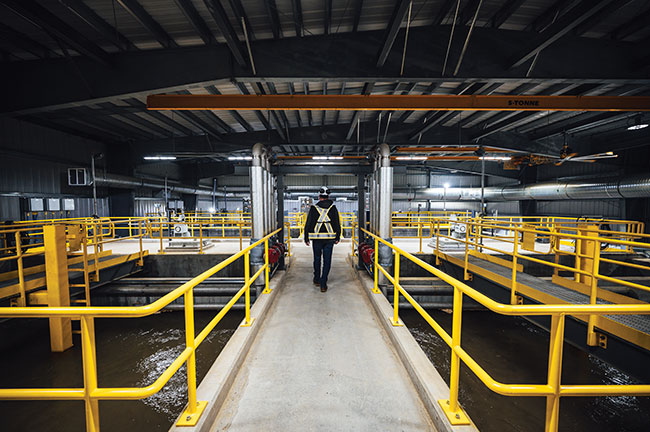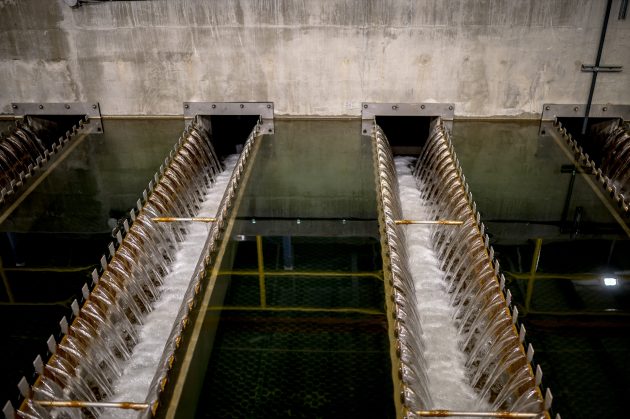
Features
Sluiceways to sustainability: Operations at Canfor’s cutting-edge water treatment plant
Canfor’s water treatment plant in Prince George is cleaning water for Canfor’s pulp mills, and more.
September 27, 2022 By Treena Hein
 Photo: Canfor Pulp
Photo: Canfor Pulp It’s been about two and a half years since Canfor’s newest raw water treatment plant opened its doors – or should we say its sluiceways – at the same time the company has opened a new era of sustainability for itself and Canada’s entire pulp industry.
The treatment plant, located on the unceded traditional territory of the Lheidli T’enneh Nation in Prince George, B.C., does not just supply high-quality water to the company’s Prince George and Intercontinental pulp mills, but also to other industrial facilities nearby that also require water for their processes.
Canfor plant at a glance
- Year finished: 2020
- Capital investment: $42 million
- Total construction hours: 150,000
- Facility footprint: About 3 football fields long by 2 wide
- Water-holding capacity: About 4.5 million litres, which would fill two Olympic-sized swimming pools
- Average daily processing capacity: 215 million litres
Both of the pulp mills were originally built in the 1960s without any treatment for their raw intake water, which is drawn from the Nechako River. It was a big problem every spring that, due to increased water turbidity, extra silt and other materials were drawn into the plant in the river water. These materials negatively affected mill operation. In addition, more water was needed for the production of the bleached pulp, which meant more energy use. Increased volumes of various chemicals were also required.
The new plant was constructed to filter out the sediments and organic materials that increase in the Nechako every spring and during other periods of high river turbidity throughout the year. Water quality is kept consistently high, which reduces mill maintenance requirements. And from an environmental perspective, the reduced use of water, energy and chemicals helps Canfor deliver pulp much more sustainably to its customers.
“Water is a critical resource, and water management is a key material topic of Canfor’s sustainability strategy,” explains Kelly Parfitt, manager of Engineering and Capital at Canfor Pulp. “Canfor is highly dependent on water throughout our operations, particularly in our pulp and paper mills. Our water management efforts relate to both conservation and quality. We work to streamline water quantity use, protect water quality downstream of our operations and maintain effluent discharge quality.” In 2021, Canfor Pulp’s mills collectively withdrew over 95,000 megalitres from various water sources.
At Canfor, its official Environment Policy outlines the company’s commitment to water stewardship, and its water use is managed through the company’s Environmental Management Systems. Water quality and quantity are also important parts of the company certifications through the Sustainable Forestry Initiative and Forest Stewardship Council. Both of these international certifications recognize protection of the water quality of rivers, streams, lakes, wetlands and other water bodies through companies meeting or exceeding best management practices.
Operation, challenges and more
Construction of this water treatment plant began in April 2019 and finished in November 2020. Water is pumped into the plant from the Nechako and then flows by gravity through a multi-step clarification and filtration system. Sediment removal is boosted through a process that binds particles together to increase particle size. Following several stages of treatment, a final filtration is performed. The system is designed to adjust quickly to changes in river water quality to maintain a consistent level of treated water quality. The sediments and organic materials removed from the raw river water are sent to a decanting pond.
The concrete was the biggest challenge in the design and construction of the treatment plant, but all went well because Canfor partnered with an engineering company with a solid reputation of success with other similar treatment facilities. In total, over 13.6 million kgs of reinforced concrete were used to form the plant’s walls, floors and supporting structures.

The better quality of water from this plant improves the pulp mills’ efficiency. (Photo: Canfor)
Parfitt explains that with a facility design similar to that used in municipalities across the country for the supply of drinking water, the plant is an excellent example of Canfor’s commitment to reduce water consumption and protect water quality. Specifically, in terms of improved plant operation and reduced energy use, the better water quality provided by this plant helps the mills’ heat exchangers work more efficiently to generate steam. “It has also resulted in more reliable fire protection systems, more consistent pulp quality for our customers and enhanced surplus green energy generation,” says Parfitt.
Mostly local labour was used to execute the project, she adds, “a nice boost for the community during Covid-19 travel and tourism restrictions.” She describes the plant overall as “a complex project that used expertise and effort from across Canfor and beyond,” and “something we can be all be proud of.”
Looking forward
The plant has worked as expected, but Canfor continues to explore how it can leverage the benefits of cleaner water and how plant processes might be further optimized.
Beyond this plant, Canfor – like the rest of the industry – is also engaging in other sustainability activities. In April, the company announced implementation had begun of a comprehensive plan to achieve net-zero carbon emissions by 2050. By 2030, Canfor will reduce carbon emissions from its pulp and wood products operations by 42 percent compared to its base year of 2020. This will involve investments of at least $250 million, and company leadership has indicated that based on projects identified to date, a majority of these funds will likely be invested in Western Canadian facilities. In addition, by 2024 Canfor will measure and assess its global supply chain and woodlands emissions, and set a science-based reduction target.
In late 2021, Canfor also announced an investment in Arbios Biotech’s biomass-to-low-carbon-biofuel plant in Prince George. The plant will use a specific technology to convert sawmill residues, primarily bark, into renewable biocrude which can be further processed in refineries to produce low-carbon transportation fuels. Arbios Biotech is a joint venture between Canfor and Licella Holdings.
For her part, Pratt is excited about further opportunities for Canfor to increase sustainability. In a recent Q&A for Pulp & Paper Canada and its sister publications, Parfitt noted that she is very focused in particular on adding the most sustainability value possible in capital spending.
She said the fact that Canfor has mills over 50 years old presents “wonderful opportunities to bring in expertise and really evaluate our impacts on the environment and our communities.” She added that “what I’m seeing strategically is how many synergies there are between reinvesting in infrastructure and running efficiently, as well as reducing our impact on the environment.”
Print this page